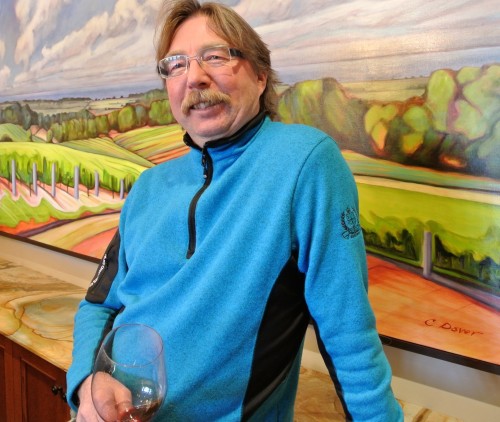
There are two sides to the wines from Rennie Estate Winery — those of character, and those of style.
Graham Rennie and his wife Christine farm 44 acres of planted fruit on their gorgeous, picturesque 50-acre site on the Beamsville Bench.
The vineyard was planted in the spring of 1999 with spacing at 1,275 vines per acre with eight-feet-wide rows. The varietal mix is 28% Pinot Noir, 17% Chardonnay, 20% Merlot, 20% Cabernet Franc and 15% Cabernet Sauvignon.
While the Rennies sell the majority of the fruit, they hold back some of the best parcels to make their namesake brand, which is produced at Malivoire winery with the help of winemaker Shiraz Mottiar.
The Pinot Noir and Chardonnay are both made traditionally and are a showcase for the vineyard and the Beamsville Bench sub-appellation, while the Bordeaux varietals are crafted into what Graham Rennie likes to call “Super Niagara” wines using the Italian method of drying grapes (appassimento) from an innovative technique developed at Vineland Research Centre specifically for the climate of Niagara.
(Rennie explains the concept and reasons he chooses this method in the video below.)
He believes the appassimento process allows for enhanced development of flavours, concentration of sugars and contributes to more complex aromas in wines made from high quality grapes harvested in cool climate areas with shorter growing seasons.
He knew what he wanted but wasn’t sure of the best method for drying grapes in Niagara. So, along with John Young (owner of Angels Gate Winery and Kew Vineyards), turned to Vineland Research and Innovation Centre for advice.
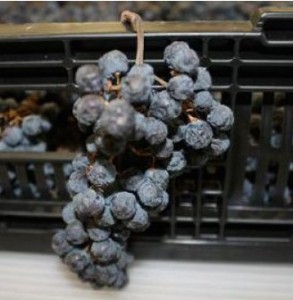 In 2011, the two owners partnered with Vineland to develop a reliable grape-drying system for their wines. “We were experimenting (with) drying grapes in a greenhouse with varying results. We wanted to perfect the ratio of temperature to humidity levels as well as to create a process that would result in a long period of slow, measured drying of our premium fruit. That’s when we approached Vineland,” said Rennie.
In 2011, the two owners partnered with Vineland to develop a reliable grape-drying system for their wines. “We were experimenting (with) drying grapes in a greenhouse with varying results. We wanted to perfect the ratio of temperature to humidity levels as well as to create a process that would result in a long period of slow, measured drying of our premium fruit. That’s when we approached Vineland,” said Rennie.
Led by Brock University’s Cool Climate Oenology and Viticulture Institute (CCOVI) and through funding provided by the Ontario Research Fund – Research Excellence program, Vineland and a number of other regional partners were already studying different drying techniques. Partnering with the two winery owners to develop a proprietary system calibrated to Ontario’s growing conditions and customized to wineries’ specifications just made sense.
“The drying methods currently used in the industry are sometimes unreliable and labour-intensive. We have developed a forced-air drying process that takes into account Ontario’s unique weather conditions and that is fully controlled and adjustable to adapt to varying harvest conditions and winery requirements,” said Dr. Bernard Goyette, Vineland’s Research Scientist, Postharvest Science. Rennie’s “G” and Scarpata, and Kew’s Soldier’s Grant wines are crafted from grapes dried by this drying system during the pilot project.
Vineland has begun building portable units housing its proprietary drying system and one is in use at Kew. Rennie dried his grapes at the unit housed at Vineland and has placed an order for his own system.

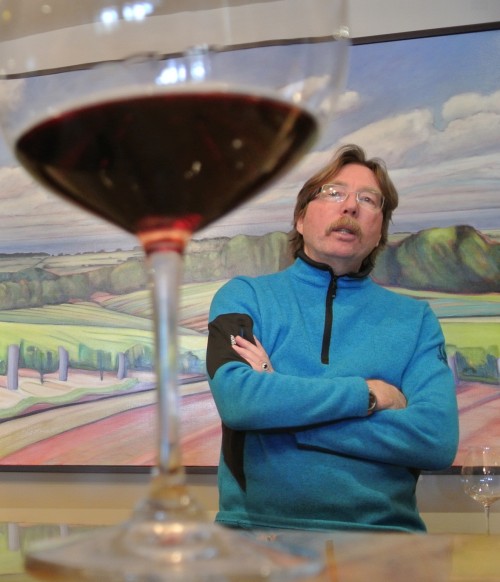
Currently, there is no “appassimento” wine category at the Liquor Control Board of Ontario (LCBO) and no VQA guidelines for making wines from dried grapes in Ontario.
However, in 2010 the crown corporation showed net sales nearing $40 million for this style of wine with just 8% originating from Ontario. But, since 2010, a staggering number of wines in Ontario are now made using dried grapes. There are rumblings from a group of wineries using various styles of dried grapes to form a group to lobby for their own category or at least work together to build the category.
An excellent endeavour, as the word “appassimento” on Ontario VQA labels can mean myriad things. It’s in the consumers’ best interests to know exactly how the grapes were dried.
I tasted through Rennie’s new releases, most of which are available now through the retail store at Malivoire winery, recently. Here is what I liked.
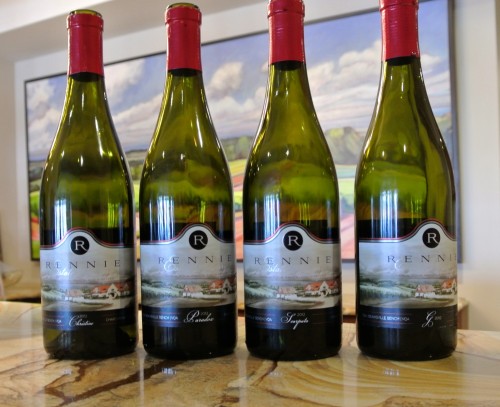
Rennie Estate Paradox Pinot Noir 2012 ($40, released this summer, 92 points)— This Pinot from a warm vintage is picked at 23 Brix, whole-cluster fermented, aged in 50% new French oak and made unfiltered. It has a generous nose of dark cherry, anise, rhubarb, raspberry, bramble, a floral note with lovely barrel oak spices. It is quite rich on the palate with concentrated red fruits, bramble, spices, some structure, youthful vigour and smooth, silky tannins. No shrinking violet here, it’s bold and sassy and built to age in the cellar.
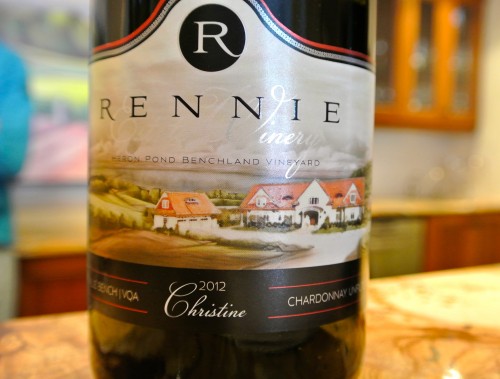
Rennie Estate Christine Chardonnay 2012 ($35, available now at Malivoire, 90 points) — A lot going here on the nose of this voluptuous Chardonnay including poached pear, vanilla, tropical mango and papaya, nutmeg and baked apple notes. It’s juicy, rich and spicy on the palate, more California than Burgundy, with pear, apple and tropical fruit with a balancing zesty citrus note on the finish.
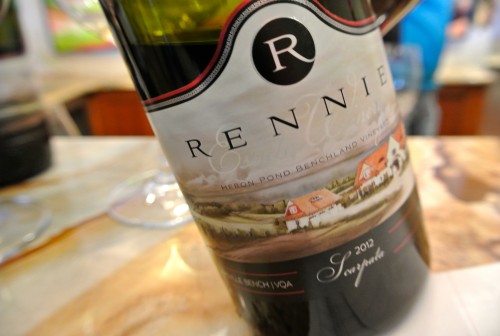
Rennie Estate Scarpata Merlot 2012 ($45, available now at Malivoire, 91 points) — Made in the Ripasso style by adding the Merlot to the leftover lees from the Rennie “G” wine (a blend of Merlot, Cabernet Franc and Cabernet Sauvignon). The leftover lees are combined and the already fermented Merlot is added to the tank where a secondary fermentation takes place. Rennie calls this a “Merlot squared event” where the wine’s alcohol goes from 13% to 15% during the process from the natural reaction of yeast interacting with the skins. The nose shows expressive aromatics of ripe raspberry, super concentrated cherry, anise, licorice, bramble, blueberry and oak spices. It is highly structures with evident tannins but backed up by rich, flavourful fruits and spice. It is no doubt a big wine that will need time to resolve those meaty tannins, or enjoy now with a grilled hunk of red meat. An interesting take on Merlot.
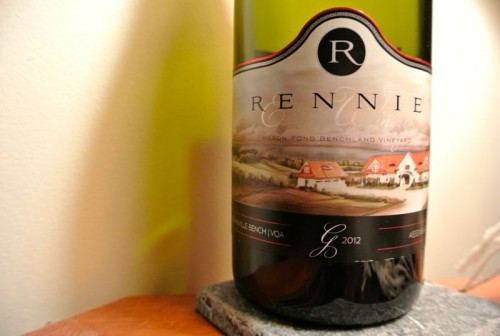
Rennie Estate “G” 2012 ($55, 93 points) — The flagship wine from Rennie, it’s a blend of Merlot (50%) and equal amounts of estate Cab Sauv and Cab Franc and made in the appassimento method. The grapes are “slow dried” in a specially designed drying chamber made in consultation with the Vineland Research Centre. The chamber features humidity, temperature and airflow controls and results in no mould whatsoever in the process. The grapes for “G” were dried for 103 days resulting in 50% loss of yield. Average Brix at time of picking was 21.7 and 27.9 after drying. This is as lavish and showy a red wine as you’ll find in Niagara with big, concentrated layers of black currants, cherries, raspberries, earth and spices that come at you in waves. It is a mouthful at the moment, huge tannins, bountiful red and dark fruits and barrel spices that are complex and tight and need time to all integrate properly. If you have the patience, wait for it, this will be a nice addition to your cellar.
